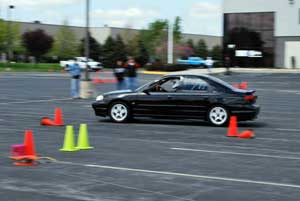(Content borrowed from the wikipedia site)
Autocross is a form of motorsports that emphasizes safe, low-cost competition and active participation. An autocross is a timed competition where drivers navigate one at a time through a temporary course marked by traffic cones, rather than racing on a track with multiple other cars, as in road racing or oval racing. Autocross tends to place more emphasis on car handling and driver skill than on sheer horsepower, and events typically have many classes which allow almost any vehicle, from economy sedans to purpose-built vehicles, to compete. Speeds are slower in absolute terms when compared to other forms of motorsports, usually not exceeding highway speeds, but the activity level (measured in discrete turns per minute) can be higher than even Formula One due to the large number of elements packed into each course. Autocross courses are typically 40 to 70 seconds in length. In addition to being a national-level motorsport in its own right, autocrossing is a good way to learn skills that transfer to road racing, as drivers learn vehicle control and club ethics.
Autocross events are usually held in large paved areas like parking lots or airfields. Typically, new courses are created for each event so drivers must learn a new course each time they compete. Prior to driving, a competitor will walk the course, taking mental notes, and developing a strategy to be refined upon subsequent runs. National organizations such as the Sports Car Club of America (SCCA) and National Auto Sport Association (NASA) sponsor autocross events throughout the United States, and many areas have independent autocross clubs. Automobile manufacturers and their associated clubs (e.g. the BMW Car Club of America) sometimes hold marque autocross events.
Participation
One of the primary attractions of autocross is that it is an inexpensive way to get involved in motorsports. The potential for car damage is low because of autocross’ low average speeds, lack of physical obstacles, and lack of wheel-to-wheel racing. For this reason, most autocross participants compete in “daily drivers”, which is not the case in most other forms of motorsport. Many clubs further reduce the barriers to entry by including classes and instruction specifically for novice drivers. You will need a helmet, but most hosting organizations have loaners for the novice attendee.
The SCCA has ladies classes for autocross which share the same rules as the open classes but limit participation to women. It is common for husbands and wives, boyfriends and girlfriends, brothers and sisters or even two unrelated drivers to share the same car, but run it in their car’s open class and its corresponding ladies class. The SCCA ensures that the ladies class for any given class is never run at the same time as the matching open class, specifically to allow car sharing in this manner. Women are not, however, prohibited from running in the open classes if they desire and many do so quite successfully.
Cars and classing
Classes and rules vary from sanctioning body to sanctioning body, but typically the majority of competitors run lightly modified or unmodified (stock) vehicles. SCCA classing, which is also adopted by many independent clubs, has a variety of Stock classes which range from Super Stock for cars like the Corvette Z06 (either the C5 or C6 variants) and Lotus Elise, to H Stock for Honda Civics and Mini Coopers. The Stock classes allow very little change from how the car was originally manufactured; most items that can be changed are the normal wear items (filters, street-legal tires, shocks/struts, ignition wires). Just beyond Stock, there are Street Touring and Street Prepared classes which allow mild modifications, such as those to suspension (wheels, springs, shocks), external engine parts (intakes and exhaust manifolds), and interior (replacement of seats, not removal).
At the other end of the spectrum, the most significantly altered production vehicles that are mostly still street legal are the Street Modified cars, which retain production-based bodies and motors but little else that is stock. Street Modified cars often produce in excess of 350 WHP, can reach 60 mph from a standing start in less than 3.4 seconds, and can corner in excess of 1.7 transient lateral Gs. Prepared class is for production-based full-on race cars with stripped interiors, major suspension changes, heavily modified motors, and true racing slick tires. Typically, Prepared class cars are no longer legal for street use and are trailered to events. The SCCA D- and E-Modified classes also have production car backgrounds, but extend the Street Modified and Prepared allowances to silhouette level, allowing any automotive-based engine, total suspension redesign, and complete replacement of the body (typically with lightweight alloys or composites) as long as the general shape of the original car is still recognizable.
There are usually classes for purpose-built race cars imported from other series (including Formula Fords, Formula Atlantics, Formula 500s and vehicles similar to American oval-track stock cars) but most autocross cars are based on production cars.
The fastest autocross cars are purpose-built “specials” (A Modified in SCCA Solo) with small lightweight bodies, sticky tires, wild wings, powerful engines, and short gears. While their top speeds are typically limited by gearing, their transient cornering capabilities far exceed those of vehicles not expressly designed for autocross use.

